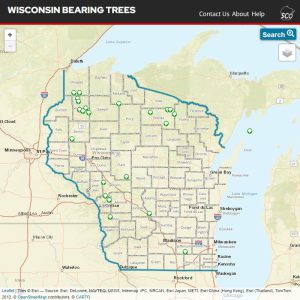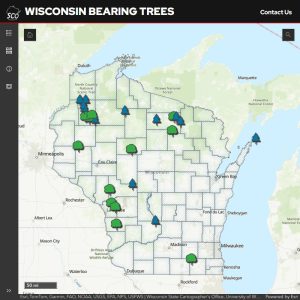As part of our continued migration to the ArcGIS Online ecosystem, we’re excited to announce the release of the new version of the Wisconsin Bearing Trees app. This application helps identify, document and preserve one of the most unique and historically significant elements in Wisconsin land surveying.
1. What are Bearing Trees?
Bearing trees, also known as witness trees, were used as natural reference points during early land surveys in the United States. When the Public Land Survey System (PLSS) was introduced in the 1800s to divide and allocate land across the expanding western territories, surveyors marked key boundaries using wooden posts. To ensure these points could still be found if the posts were lost or damaged, nearby trees were selected and recorded as fixed references.
These trees were chosen for their size, visibility and longevity. Surveyors would blaze the bark and document important details such as species, diameter, distance and compass bearing from the survey corner. Over time, these bearing trees became reliable, long-lasting indicators of property lines.
Today, bearing trees offer more than historical interest. They provide valuable insights into the landscape before large-scale development. Ecologists and historians use the records from these early surveys to study pre-settlement forest composition, land use patterns and environmental change over time.
2. What is the PLSS?
The Public Land Survey System (PLSS) was developed by the US government in the 18th century. Its goal was to partition land in a systematic way to facilitate the conveyance of federal land to states and private citizens. The PLSS organizes land into a grid of townships and sections with clearly demarcated boundaries. In Wisconsin, the PLSS survey was conducted between 1832 and 1866.
Understanding the PLSS is key to grasping how the American landscape was mapped and managed. It remains a foundational system that continues to influence land ownership and legal boundaries today. If you’re interested in learning more about the PLSS and its lasting relevance, we invite you to join us at the PLSS Forum on May 15. This event is a great opportunity to explore the system and connect with others interested in land history, mapping, and environmental change.
3. Technical Notes About the New App
While the Pronounce Wisconsin app we launched last week was built using Experience Builder, the Wisconsin Bearing Trees app was created with Instant Apps – Sidebar. This template gave us the flexibility we needed, and we were pleased to find that some Instant Apps now support customization features that align with our design system.
For example, we used custom CSS in the Theme & Layout settings to adjust fonts, colors and logo placement to match our branding. To ensure the app had its own unique identity, we also introduced several design enhancements.
One standout feature is the set of custom tree icons that distinguish between coniferous and deciduous species. We also applied a faded inner-glow effect, inspired by John Nelson’s tutorial on ArcGIS Online Web Maps. This subtle effect complements the hand-drawn look of the icons and adds a historical character to the interface.
In addition, we made photos and original survey records previewable, giving users a glimpse into what early surveyors might have seen. These features help the app feel like a digital time capsule, offering both visual and historical context at a glance.
Overall, the migration to ArcGIS Online has made the data more accessible, interactive, and visually engaging.


▲ Previous and current versions of Wisconsin Bearing Trees
4. Explore the New App
One of the most rewarding aspects of this project is the community behind it. Many of the photos featured in the app were generously contributed by volunteers. In fact, if you look closely, you might find a fun easter egg: some of the images were submitted by our very own team lead, State Cartographer Howard Veregin.
We invite you to explore the app and see it as a snapshot of Wisconsin’s surveying history. If you happen to visit any of the bearing trees in person, we would love to see your photos or hear your observations. Every contribution helps keep this living history alive.
